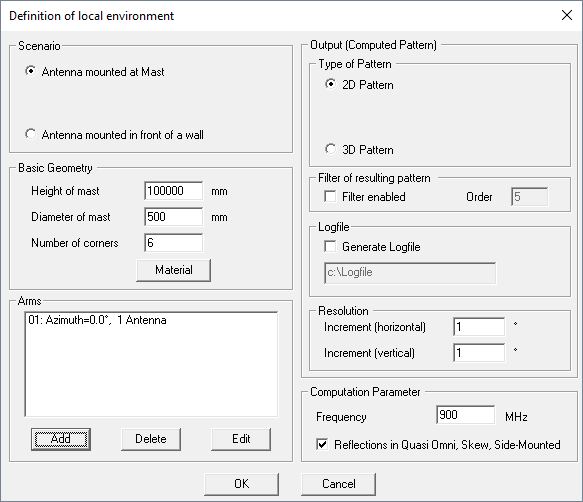Main Settings
- View group, Objects check box
- The drawing of the objects (wall, mast, arms, radomes) can be enabled or disabled. If displayed this helps to understand the configuration and if not displayed it helps to analyze the details of the pattern computed by MASC.
- Configuration button
- With this button, the dialog to define the configuration is called.

Figure 1. Control panel in MASC mode.

Figure 2. Main settings of MASC configuration.
Scenario
Here you can select if a mast configuration or a configuration in front of a wall is computed.
Basic Geometry
-
- Mast
- The height of the mast and its diameter must be defined. And the number of corners to be used to approximate the circular cross-section with a polygon.
-
- Wall
-
The length of the wall must be defined (Wall is squared. The length applies therefore to all wedges). And the rotation of the wall. 0° means the wall is parallel to a vector from west to east and perpendicular to a vector from north to south. As the north is always assumed to be 0°, the wall can be rotated against the arms.
Arms
In this area, the user can add arms to the mast or wall (depending on the scenario). Or arms can be deleted if they are no longer required.
Of course, it is also possible to edit the properties of an arm.
The number of arms supported is only limited by the RAM of the PC.
Output (Computed Pattern)
The type of output pattern can be defined. Either the very fast computed 2x2D pattern or the full 3D pattern can be computed.
Additionally, a filter can be enabled to smooth the resulting pattern. The order of the filter can also be defined.
For debugging purposes, a log file can be enabled.
The resolution of the resulting pattern can also be defined. The finer the resolution, the longer the computation time and the more accurate the result. Resolutions below 1° are not possible.
Computation Parameters
To consider the phase correctly when superposing the signals), the frequency must be defined here.
Additionally, the consideration of reflections for the mast configurations can be enabled. This extends the computation time – but improves the accuracy. In the wall configuration, the reflections are always determined.